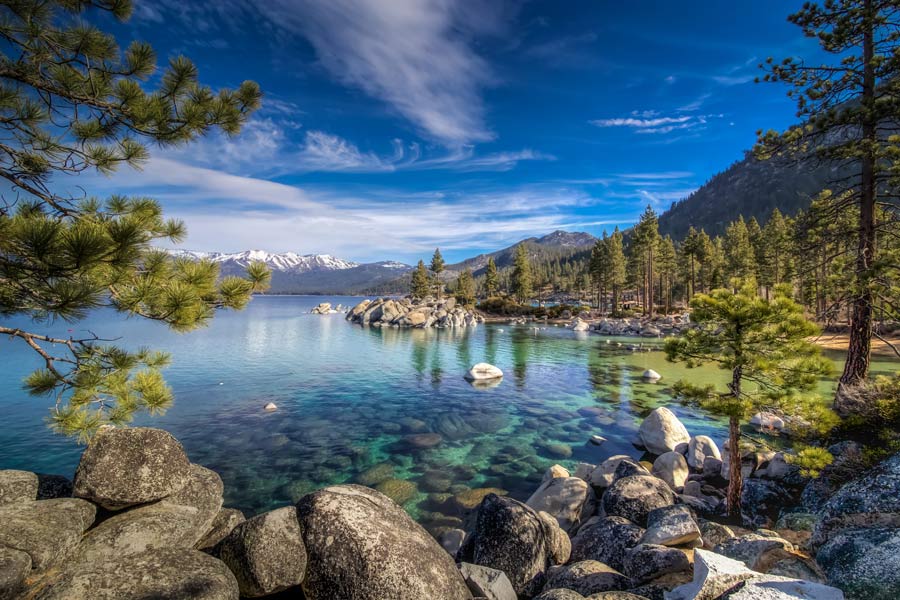Keeping Tahoe Blue with Science (Opinion)
This past year has been a rollercoaster for the Lake Tahoe region. As the coronavirus pandemic dragged on, undeterred visitors continued to flock to the area.
In August, the Caldor Fire threatened the Lake Tahoe Basin, forcing 30,000 people to evacuate for weeks. An atmospheric river in October brought threats of flooding, only to be followed by huge storms and record-setting snow in December. Through it all, the Tahoe Science Advisory Council has been working to understand the impacts of these events on our Jewel of the Sierra.
For more than 60 years, science has helped protect and preserve Lake Tahoe. In the 1960s, it was used to stop sewage effluent from entering the Lake. In the 1980s, science helped rein in out-of-control development to protect Tahoe’s famed water clarity. In the 2000s, it guided the development of the invasive species prevention and control program to protect Tahoe’s fragile ecology. Today, the Council continues the tradition by using science to Keep Tahoe Blue.
Before the Caldor Fire reached Tahoe, Council scientists were collecting data and taking measurements to understand how thick smoke and ash were impacting Lake Tahoe’s crystal-clear waters. After the fire was contained, professional teams backed by citizen scientists were on the ground sampling and testing streams that drain the scorched slopes to understand how water quality was affected. A Council project is also exploring how decades of forest management work, including forest thinning, helped save homes in Christmas Valley and Meyers.
The Caldor Fire and the local impacts of our changing climate highlight the need for sound science to enhance understanding of our environment and better inform management decisions. How does extreme wildfire impact the Lake? How can we better manage visitor impacts? How will warming temperatures change the Lake, forests, and how we live and play in Tahoe?
Luckily, there is no shortage of highly trained and dedicated scientists committed to understanding and protecting the Tahoe Basin. In 2015, California and Nevada established the Tahoe Science Advisory Council to help wrestle challenging natural resource management questions and assist agency partners in understanding our complex Lake and watershed. The group is made up of two members from six different institutions, providing a wide range of expertise. Some Council members have institutional knowledge gained from studying Lake Tahoe for decades, while others bring fresh perspectives and ideas to the table. There are two members from each of the following institutions: the Desert Research Institute; University of Nevada, Reno; the University of California, Davis; the University of California, Santa Barbara; the U.S. Forest Service Pacific Southwest Research Station; and the U.S. Geological Survey. The Council is also supported by the California Natural Resources Agency and the Nevada Department of Conservation of Natural Resources, along with local conservation groups including the League to Save Lake Tahoe. Together, this diverse group of experts is collaboratively tackling some of Lake Tahoe’s most challenging science questions.
To date, the Council has led projects to understand what factors influence Lake Tahoe’s famed water clarity, reviewed science needs to care for upland forests and meadows, and supported Tahoe Regional Planning Agency efforts to update environmental standards that protect Tahoe’s environment.
The Council is excited to continue its work in 2022. In addition to ongoing wildfire impacts research and lake clarity modeling, a Council team will work with partners to develop an “Integrated Science to Action Plan” that will set the course for science investments in the Lake Tahoe area. Working in partnership with land and natural resource managers, scientists will identify priority projects to improve our understanding of how Lake Tahoe is changing and help guide programs and policies to ensure it remains blue, beautiful, and resilient in the face of climate change and human impacts.
For the better part of a century, science has helped preserve what so many love about the Lake. The Council is honored to carry on that Tahoe tradition. In the coming months, Council members will use this column to share a bit about themselves and their ongoing work, including what we learn from our research at Lake Tahoe.
To learn more, please visit the Tahoe Science Advisory Council’s website: tahoesciencecouncil.org.
Robert Larsen, Council Program Officer, California Natural Resources Agency
Darcie Goodman Collins, PhD, Chief Executive Officer, League to Save Lake Tahoe / Keep Tahoe Blue

Support Local Journalism

Support Local Journalism
Readers around the Lake Tahoe Basin and beyond make the Tahoe Tribune's work possible. Your financial contribution supports our efforts to deliver quality, locally relevant journalism.
Now more than ever, your support is critical to help us keep our community informed about the evolving coronavirus pandemic and the impact it is having locally. Every contribution, however large or small, will make a difference.
Your donation will help us continue to cover COVID-19 and our other vital local news.








